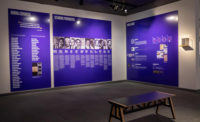There’s a perceptible cloud of pessimism hanging over the 10th edition of the International Design Biennial of Saint Etienne, on view now in the former coal town southwest of Lyon, France, through Sunday. Inspired by this year’s theme Working Promise: Shifting Work Paradigms, designers, architects, and artists examine the possibilities of a workforce replaced by robots, the desirability of certain professions based on workers’ success on Tinder, and the imminent demise of capitalism.
“There are many points of view in this biennale, and cynicism is definitely one of them,” says biennale scientific director Olivier Peyricot, citing the unknowns of technology and post-capitalism as major themes. Take “The Ascent,” by London-based writer Ilona Gaynor, which re-envisions the workplace as the interior of an airplane. In her accompanying play, the plane crashes, and the passengers suffer comically grisly deaths.
Despite the show’s dark overtones, there is one hopeful theme: “When it comes to strategies for new communities, Detroit is a very good example of a rebuilt society that Saint Etienne could learn a lot from,” according to Peyricot.
Peyricot invited a trio of exhibitions from Detroit advocacy organizations to the biennial, andRather than speculate about the future, they examine design-based solutions for the present. The Detroit Creative Corridor Center and Public Design Trust’s “Footwork” showcases Detroit-made contemporary furniture and textiles in a traditional exhibition format, while Creative Many Michigan’s “ShiftSpace” goes a step further, displaying the work of civically-minded Detroit-based artists and designers in the context of a fully-functioning coffee shop. It’s both an active co-working space and a site for opening-weekend discussions, such as the implications of a basic universal income.
“Design is often called into account when we want to think about the exceptional, like flying cars or the autonomous vehicle,” says Creative Many industries director Cezanne Charles. “But if you think of the Jetsons, George had a flying car and he still worked at a factory. In that kind of future, we had clearly wildly imagined some things and totally failed to reinterpret the fundamental social contact.”
The shared theme among the Detroit contingent is urban regeneration that seeks more than "bringing the city back to the new normal,” says Anya Sirota of Detroit architecture firm Akoaki. Her and partner Jean Louis Farges’s “Out of Site” diverges from the traditional exhibition model most radically of all; they’ve brought with them two stages that formally reference Detroit’s black musical heritage (think the Afrofuturism of George Clinton and alter-ego Dr. Funkenstein) along with 30 Detroit-based creatives, including musicians who performed there live, and 20-or-so Detroit urban farmers, artists, and lawyers. They’ve also brought a demountable archway that, when attached to buildings, denotes the location of the nomadic Detroit Culture Council.
“We see a lot of speculative projects about how to give land value again and how we reenter the real estate market,” says Sirota, “but what we’re saying here is that the cultural aspects of Detroit precede anything else of value in the city.”
This creative-minded line of thinking is the genesis of the biennial, which takes place on the renovated site of a former arms factory that is now the Cité du Design. The Saint-Etienne Regional School of Fine Arts founded the exhibition in 1998 as a platform to discuss design as a force for economic innovation. Like Detroit, Saint-Etienne had been suffering its own industrial collapse following France’s shuttering its coalmines in the 1970s in favor of nuclear power. What ensued was an economic and population decline. (Occupancy at Site Le Corbusier, for example, the architect’s unsung, sprawling 1960s social housing commission for the suburb of Firminy’s then-booming population, now hovers around 50 percent.)
While they differ greatly in scale (Detroit has approximately four times the population), what the two cities have in common is “this clear stress over economic trauma,” says Sirota. And, for their respective emphasis on design, both have been designated a UNESCO Creative City. “Saint-Etienne is still 10 years ahead of Detroit in marketing the creative vibrancy of the city,” Sirota adds, “but biennials are for making a case for a method going forward.”















Post a comment to this article
Report Abusive Comment